Rhode Island is a state located in the New England region of the northeastern United States. It’s famous for its colonial seaside towns and sandy shores. However, regarding prehistoric animals, the state has a relatively sparse fossil record. During the early Paleozoic, Rhode Island was partially covered by a sea home to trilobites.
The state became a swampy environment during the Carboniferous period. Local animal life consisted of arachnids and insects like cockroaches. A Providence clergyman discovered a fossilized wing of a prehistoric cockroach in Pawtucket near the end of 1892.
No dinosaur fossils have ever been excavated in Rhode Island. Besides, little is known about the state’s Triassic, Jurassic, Paleogene, Neogene, and Cretaceous history. Nevertheless, that doesn’t mean it was entirely devoid of prehistoric life. Read on and discover the 8 extinct animals that lived in Rhode Island.
8 Extinct Animals That Lived in Rhode Island
Although Rhode Island has a huge gap in its geologic and fossil record, the state was home to many prehistoric animals, including numerous insects, marine mammals, and ancient amphibians.
Here are the 8 extinct animals that called Rhode Island home:
1. Trilobite

The largest trilobites measured approximately 18 inches long and weighed about 9.9 pounds.
©iStock.com/Aunt_Spray
| Trilobite | |
|---|---|
| Kingdom | Animalia |
| Phylum | Arthropoda |
| Clade | Arachnomorpha |
| Subphylum | Trilobitomorpha |
| Class | Trilobita |
| Living period | Early Cambrian period until the end of Permian, about 521 million to 252 million years ago |
Trilobites were among the marine arthropods that date back to the Early Cambrian period until their final disappearance in the mass extinction at the end of the Permian. They are among the most successful aquatic animals, with over 20,000 species. They were highly diversified and geographically dispersed in the oceans for almost 270 million years, which is why they left an extensive fossil record.
The largest trilobites measured approximately 18 inches long and weighed about 9.9 pounds. They evolved into many diverse ecological niches. Some swam in the oceans, feeding on plankton, while others moved over the seabed as filter feeders, scavengers, or predators. Some even crept onto land.
2. Protophasma
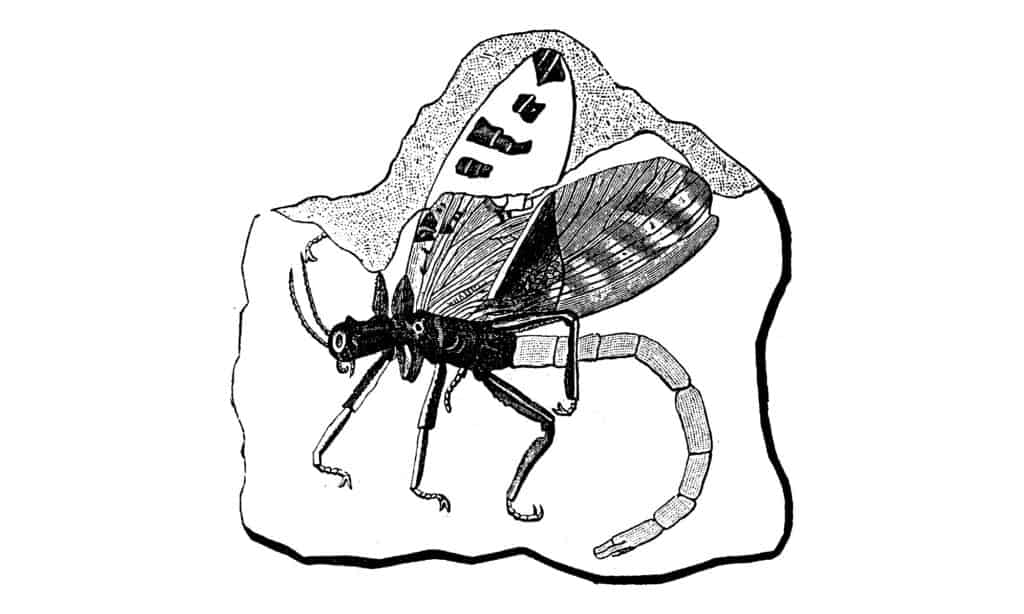
Protophasma was among the earliest known winged insects in the fossil record.
©Morphart Creation/Shutterstock.com
| Protophasma | |
|---|---|
| Kingdom | Animalia |
| Phylum | Arthropoda |
| Subphylum | Hexapoda |
| Class | Insecta |
| Superorder | Orthopterida |
| Order | Incertae sedis |
| Family | Protophasmatidae |
| Genus | Protophasma |
| Living period | Carboniferous, about 359.2 million to 299 million years ago |
Protophasma is an extinct species of the genus Protorthopteran insect that lived during the Carboniferous period. It was among the earliest known winged insects in the fossil record. The morphology of its hindwings was similar to that of Blattodea, an order of insects that includes termites and cockroaches. Its forewings bore a striking resemblance to the species from the cohort Archaeorthoptera.
3. Albanerpeton
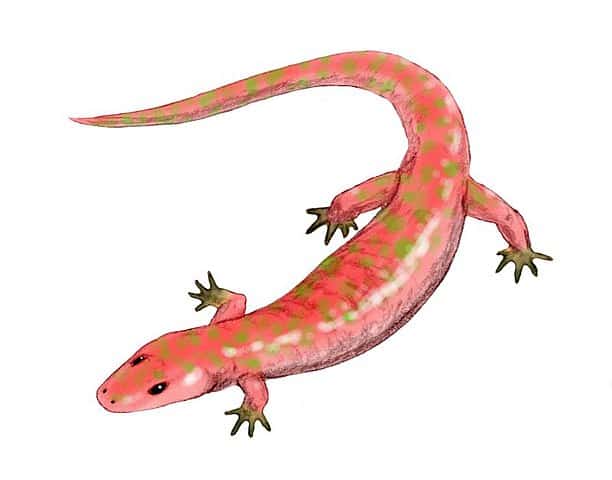
Albanerpeton was a salamander-like lissamphibian that first appeared in Cretaceous-aged strata in North America and Europe.
©Nobu Tamura / CC BY 3.0 – License
| Albanerpeton | |
|---|---|
| Kingdom | Animalia |
| Phylum | Chordata |
| Class | Amphibia |
| Order | Allocaudata |
| Family | Albanerpetontidae |
| Genus | Albanerpeton |
| Living period | The middle Jurassic to the beginning of Pleistocene, about 160 million to 2 million years ago |
Albanerpeton was a salamander-like lissamphibian that first appeared in Cretaceous-aged strata in North America and Europe. This species preferred cold and humid environments and went extinct when the region developed its present Mediterranean-type climate. It had a robust neck that facilitated burrowing. Based on fossil examination, the dental edge of its dental boundary was curved on its lingual side. Its teeth were relatively large since they were about one-third of the distance from the anterior end of the tooth row.
4. Adelospondylus
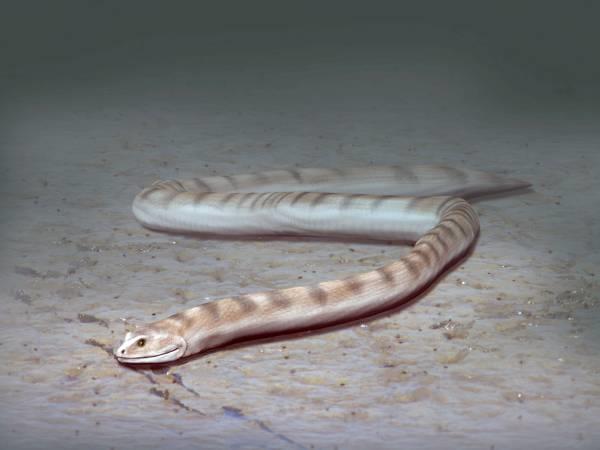
Adelospondylus is an extinct lepospondyli amphibian from the Early Carboniferous to the Early Permian.
©Nobu Tamura / CC BY-SA 4.0 – License
| Adelospondylus | |
|---|---|
| Kingdom | Animalia |
| Phylum | Chordata |
| Order | Adelospondyli |
| Family | Adelogyrinidae |
| Genus | Adelospondylus |
| Living period | Early Carboniferous to the Early Permian |
Adelospondylus is an extinct lepospondyli amphibian from the Early Carboniferous to the Early Permian. Aside from Adelospondylus, there were also four major Lepospondyli groups: Nectridea, Lysorophia, Aistopoda, and Microsauria. None of these species were large. Their body shapes ranged from lizard-like and snake-like to eel-like and newt-like forms. They also lived in diverse habitats.
Like other Lepospondylis, Adelospondylus had a simple, spool-shaped vertebra that did not ossify the cartilage. Instead, the vertebrae grew as bony cylinders around the notochord. The upper part of the vertebrae was fused to the main body.
5. Amphibamus
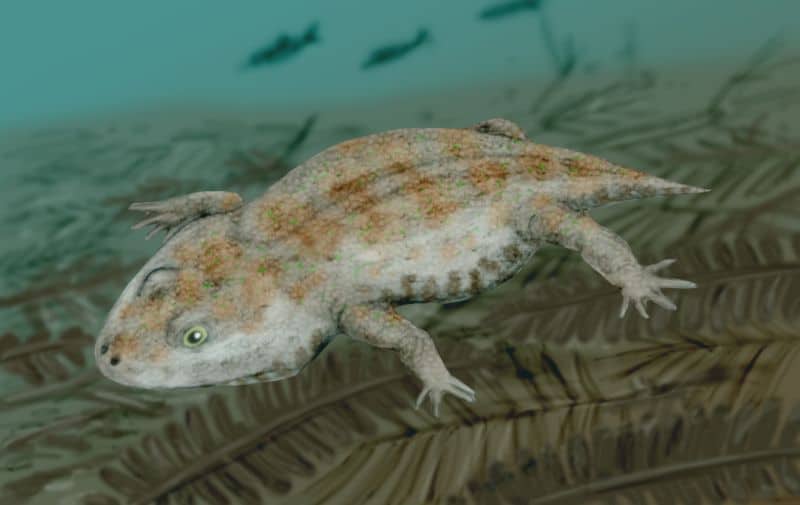
Amphibamus could grow up to 0.65 feet in total length.
©Nobu Tamura / CC BY 3.0 – License
| Amphibamus | |
|---|---|
| Kingdom | Animalia |
| Phylum | Chordata |
| Class | Amphibia |
| Order | Temnospondyli |
| Family | Amphibamidae |
| Genus | Amphibamus |
| Species | Amphibamus grandiceps |
Amphibamus is an extinct group of amphibians from the Carboniferous period. Although the current population of frogs, toads, and salamanders is small and rapidly dwindling, millions of years ago, spanning the late Carboniferous and the Early Permian periods, amphibians were the dominant terrestrial animals on Earth.
There is a possibility that modern lissamphibians may have originated from the Late Carboniferous Amphibamus, though not all researchers support this theory. Amphibamus could grow up to 0.65 feet (20 cm) in total length.
6. Archegosaurus
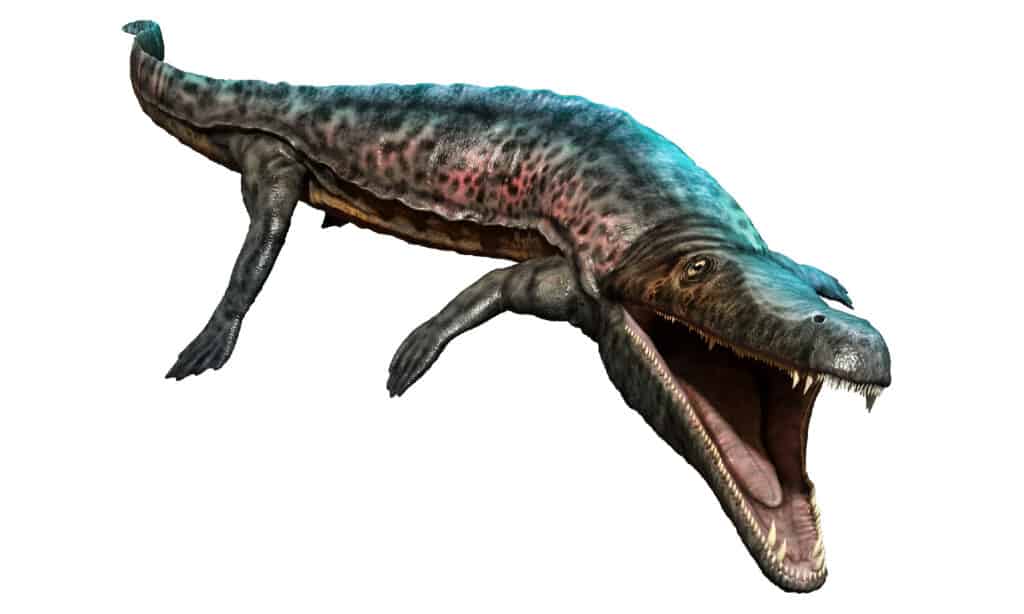
Archegosaurus is an extinct genus of temnospondyl amphibians that lived between 299 and 253 million years ago.
©iStock.com/Warpaintcobra
| Archegosaurus | |
|---|---|
| Kingdom | Animalia |
| Phylum | Chordata |
| Class | Amphibia |
| Order | Temnospondyli |
| Family | Archegosauridae |
| Genus | Archegosaurus |
| Living period | The Asselian to Wuchiapingian stages of the Permian, about 299 million to 253 million years ago |
Archegosaurus is an extinct genus of temnospondyl amphibians that lived between 299 and 253 million years ago. Its footprints and those of other prehistoric amphibians have been discovered in the Rhode Island Formation. About 90 partial skeletons of Archegosaurus have been found in Germany.
A study regarding Archegosaurus digestion, osmoregulation, gas exchange, and metabolism reveals that this species was an aquatic animal. It was more similar to fish than to present-day amphibians such as salamanders.
7. Rhyniognatha
| Rhyniognatha | |
|---|---|
| Kingdom | Animalia |
| Phylum | Arthropoda |
| Genus | Rhyniognatha |
| Species | Rhyniognatha hirsti |
| Living period | Early Devonian, about 400 million years ago |
Rhyniognatha is an extinct genus of arthropods from the Early Devonian. It is the world’s oldest insect and appeared when Earth’s first terrestrial ecosystems were formed. This species was named and described in 1928 based on collected specimens dating back to about 400 million years ago.
Rhyniognatha typically fed on plant sporophylls like other insects of its time. It had large mandibles that were presumably used for hunting.
8. Meganeura

Meganeura is an extinct group of insects that lived during the Late Carboniferous.
©andrey oleynik/Shutterstock.com
| Meganeura | |
|---|---|
| Kingdom | Animalia |
| Phylum | Arthropoda |
| Class | Insecta |
| Division | Paleoptera |
| Superorder | Odonatoptera |
| Order | Meganisoptera |
| Family | Meganeuridae |
| Genus | Meganeura |
| Living period | Late Carboniferous, about 300 million years ago |
Meganeura is an extinct group of insects that lived during the Late Carboniferous. It was similar in appearance to modern damselflies and dragonflies. Meganeura was a carnivorous creature whose diet mainly consisted of other insects.
This species grew to an immense size, partly due to the extra oxygen levels that used to be in the Earth’s atmosphere and partly due to the lack of predators. It had an elongated tail, two long antennae, and four large wings. Its wingspan was approximately 25.6 to 28 inches long.
The photo featured at the top of this post is © iStock.com/Aunt_Spray
Thank you for reading! Have some feedback for us? Contact the AZ Animals editorial team.






